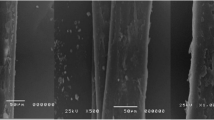Abstract
Oat contains different components that possess antioxidant properties; no study to date has addressed the antioxidant effect of the extract of oat bran on the cellular level. Therefore, the present study focuses on the investigation of the protective effect of oat bran extract by enzymatic hydrolysates on human dermal fibroblast injury induced by hydrogen peroxide (H2O2). Kjeldahl determination, phenol-sulfuric acid method, and high-performance liquid chromatography (HPLC) analysis indicated that the enzymatic products of oat bran contain a protein amount of 71.93%, of which 97.43% are peptides with a molecular range from 438.56 to 1 301.01 Da. Assays for 1,1-diphenyl-2-picrylhydrazyl (DPPH) radical scavenging activity indicate that oat peptide-rich extract has a direct and concentration-dependent antioxidant activity. 3-(4,5-Dimethylthiazol-2-yl)-2,5-diphenyl tetrazolium bromide (MTT) colorimetric assay and the TdT-mediated digoxigenin-dUTP nick-end labeling (TUNEL) assay for apoptosis showed that administration of H2O2 in human dermal fibroblasts caused cell damage and apoptosis. Pre-incubation of human dermal fibroblasts with the Oatp for 24 h markedly inhibited human dermal fibroblast injury induced by H2O2, but application oat peptides with H2O2 at same time did not. Pre-treatment of human dermal fibroblasts with Oatp significantly reversed the H2O2-induced decrease of superoxide dismutase (SOD) and the inhibition of malondialdehyde (MDA). The results demonstrate that oat peptides possess antioxidant activity and are effective against H2O2-induced human dermal fibroblast injury by the enhanced activity of SOD and decrease in MDA level. Our results suggest that oat bran will have the potential to be further explored as an antioxidant functional food in the prevention of aging-related skin injury.
Similar content being viewed by others
References
Beck, E.J., Tosh, S.M., Batterham, M.J., Tapsell, L.C., Huang, X.F., 2009. Oat β-glucan increases postprandial cholecystokinin levels, decreases insulin response and extends subjective satiety in overweight subjects. Mol. Nutr. Food Res., 53(10):1343–1351. [doi:10.1002/mnfr.200800343]
Chen, C.O., Milbury, P.E., Collins, F.W., Blumberg, J.B., 2007. Avenanthramides are bioavailable and have antioxidant activity in humans after acute consumption of an enriched mixture from oats. J. Nutr., 137:1375–1382.
Cini, M., Fariello, R.G., Bianchetti, A., Moretti, A., 1994. Studies on lipid peroxidation in the rat brain. Neurochem. Res., 19(3):283–288. [doi:10.1007/BF00971576]
Collins, F.W., McLachlan, D.C., Blackwell, B.A., 1991. Oat phenolics: avenalumic acids, a new group of bound phenolic acids from oat groats and hulls. Cereal Chem., 68:184–189.
Feng, B., Wang, C.T., Lei, F., Dong, Y.M., 2007. Study on hydrolysis conditions of oat bran protein with different proteinase. Sci. Technol. Food Ind., 10:120–122 (in Chinese).
Feng, B., Ye, W.L., Ma, L.J., Fang, Y., Mei, Y.A., Wei, S.M., 2012. Hydrogen peroxide enhanced potassium currents and promoted cell injury in human fibroblasts. Life Sci., 90(11–12):424–431. [doi:10.1016/j.lfs.2011.12.020]
Gillitzer, R., Goebeler, M., 2001. Chemokines in cutaneous wound healing. J. Leuk. Biol., 69:513–521.
Hansen, M.B., Nielsen, S.E., Berg, K., 1989. Re-examination and further development of a precise and rapid dye method for measuring cell growth/cell kill. J. Immunol. Meth., 119(2):203–210. [doi:10.1016/0022-1759(89)90397-9]
Jung, S.H., Kang, K.D., Ji, D., Fawcett, R.J., Safa, R., Kamalden, T.A., 2008. The flavonoid baicalin counteracts ischemic and oxidative insults to retinal cells and lipid peroxidation to brain membranes. Neurochem. Intern., 53(6–8):325–337. [doi:10.1016/j.neuint.2008.09.004]
Klamt, F., Shacter, E., 2005. Taurine chloramine, an oxidant derived from neutrophils, induces apoptosis in human B lymphoma cells through mitochondrial damage. J. Biol. Chem., 280(22):21346–21352. [doi:10.1074/jbc.M5011 70200]
Klamt, F., Zdanov, S., Levine, R.L., Pariser, A., Zhang, Y., Zhang, B., 2009. Oxidant-induced apoptosis is mediated by oxidation of the actin-regulatory protein cofilin. Nat. Cell Biol., 11(10):1241–1246. [doi:10.1038/ncb1968]
Lahogue, V., Réhel, K., Taupin, L., Haras, D., Allaume, P., 2010. A HPLC-UV method for the determination of angiotensin I-converting enzyme (ACE) inhibitory activity. Food Chem., 118(3):870–875. [doi:10.1016/j. foodchem.2009.05.080]
Luo, T., Xia, Z., 2006. A small dose of hydrogen peroxide enhances tumor necrosis factor-α toxicity in inducing human vascular endothelial cell apoptosis: reversal with propofol. Anesth. Analg., 103(1):110–116. [doi:10.1213/01.ane.0000221183.02244.80]
Marlett, J.A., 1993. Comparisons of Dietary Fiber and Selected Nutrient Compositions of Oat and Other Grain Fractions. In: Wood, P.J. (Ed.), Oat Bran. American Association of Cereal Chemists, p.49–82.
Masood, S.B., Muhammad, T.N., Muhammad, K.I.K., Rabia, S., Mehmood, S.B., 2008. Oat: unique among the cereals European. J. Nutr., 47(2):68–79.
Niu, Y., Xie, T., Ge, K., Lin, Y., Lu, S., 2008. Effects of extracellular matrix glycosylation on proliferation and apoptosis of human dermal fibroblasts via the receptor for advanced glycosylated end products. Am. J. Dermatopathol., 30(4):344–351. [doi:10.1097/DAD.0b013e31816a8c5b]
Ohshima, S., 2004. Apoptosis in stress-induced and spontaneously senescent human fibroblasts. Biochem. Biophys. Res. Commun., 324(1):241–246. [doi:10.1016/j.bbrc. 2004.09.044]
Peterson, D.M., 2001. Oat antioxidants. J. Cereal. Sci., 33(2):115–129. [doi:10.1006/jcrs.2000.0349]
Reiter, R.J., Tan, D., Osuna, C., Gitto, E., 2000. Actions of melatonin in the reduction of oxidative stress. J. Biomed. Sci., 7(6):444–458. [doi:10.1007/BF02253360]
Ren, Y., Yang, X., Niu, X., Liu, S., Ren, G., 2011. Chemical characterization of the avenanthramide-rich extract from oat and its effect on D-Galactose-induced oxidative stress in mice. J. Agric. Food Chem., 59(1):206–211. [doi:10.1021/jf103938e]
Venukumar, M.R., Latha, M.S., 2002. Antioxidant activity of curculigo orchioides in carbon tetrachloride-induced hepatopathy in rats. Indian J. Clin. Biochem., 17(2):80–87. [doi:10.1007/BF02867976]
Wang, C.T., Han, Y., Feng, B., Dong, Y.M., 2008. Study on extraction technology of oat peptide. Sci. Technol. Food Ind., 6:232–234 (in Chinese).
Wiegand, C., Hipler, U.C., 2009. Evaluation of biocompatibility and cytotoxicity using keratinocyte and fibroblast cultures. Skin Pharmacol. Physiol., 22(2):74–82. [doi:10.1159/000178866]
Yuan, J., Murrell, G.A., Trickett, A., Wang, M.X., 2003. Involvement of cytochrome c release and caspase-3 activation in the oxidative stress-induced apoptosis in human tendon fibroblasts. Biochim. Biophys. Acta, 1641(1): 35–41. [doi:10.1016/S0167-4889(03)00047-8]
Author information
Authors and Affiliations
Corresponding author
Rights and permissions
About this article
Cite this article
Feng, B., Ma, Lj., Yao, Jj. et al. Protective effect of oat bran extracts on human dermal fibroblast injury induced by hydrogen peroxide. J. Zhejiang Univ. Sci. B 14, 97–105 (2013). https://doi.org/10.1631/jzus.B1200159
Received:
Revised:
Published:
Issue Date:
DOI: https://doi.org/10.1631/jzus.B1200159




